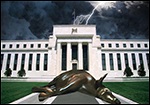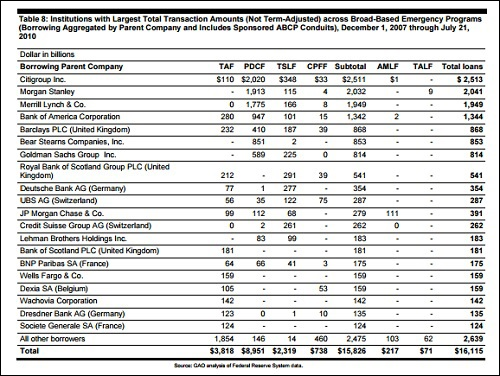CONSIDER SUBSCRIBING TO THIS NEWSLETTER FOR INFORMATION ABOUT THE FEDERAL RESERVE & WALL STREET.
Why Didn’t Vanguard, the Largest Mutual Fund Family in the U.S., Need to Borrow from the Fed while the Wall Street Titans Did?
By Pam Martens and Russ Martens: April 19, 2022 ~
 For the past week, Wall Street On Parade has been crunching the cryptic data released by the Federal Reserve on March 31 that named the mutual funds that couldn’t meet redemption requests in their money market funds in March and April of 2020 without tapping loans from the Fed.
For the past week, Wall Street On Parade has been crunching the cryptic data released by the Federal Reserve on March 31 that named the mutual funds that couldn’t meet redemption requests in their money market funds in March and April of 2020 without tapping loans from the Fed.
As we reported yesterday, the Fed loaned a cumulative total of $162.9 billion from its Money Market Mutual Fund Liquidity Facility (MMLF) in March and April of 2020 with 72 percent of that total going to just six mutual fund families: Federated $27.75 billion; JPMorgan $24.8 billion; Morgan Stanley $19.55 billion; UBS $17.3 billion; Wells Fargo $15.5 billion; and BlackRock $11.98 billion.
There are two striking aspects to this story. First, no mainstream media outlet will go near the story. The same media outlets that battled the Fed in court for more than two years to name the Wall Street firms and how much they borrowed from the Fed after the 2008 financial crash are refusing to report on the second largest Fed bailout in U.S. history. That bailout includes not just loans made by the MMLF but by over a dozen other Fed bailout facilities created in 2019 and 2020. (See our earlier report: There’s a News Blackout on the Fed’s Naming of the Banks that Got Its Emergency Repo Loans; Some Journalists Appear to Be Under Gag Orders.)
News blackouts involving major Wall Street news stories – the only industry in America running its own private justice system and a perpetual revolving door in Washington – should raise alarm bells among all Americans. We can see from Putin’s authoritarian rule in Russia what evolves from a silenced free press.
The second striking aspect is that the largest mutual fund family in America, the Vanguard Group, didn’t need to borrow a dime from the Fed. According to a report by Andrea Travillian at Investopedia on January 29 of this year, the Vanguard Group had $6.151 trillion in Assets Under Management (AUM) at that time, making it the largest “retail asset manager in the world.”
BlackRock ranks second on the Investopedia list and it needed to borrow a cumulative $11.98 billion from the Fed to bail out its money market funds while a different Fed bailout facility being run by – wait for it – BlackRock, was bailing out BlackRock’s Exchange Traded Funds (ETFs).
We reached out to Vanguard’s media relations folks to find out why it had ample liquidity of its own and didn’t need to tap a bailout facility from the Fed. We received the following response:
“For more than 30 years, Vanguard has taken a conservative and prudent approach to managing money market assets by maintaining a specific focus on capital preservation, liquidity, and income.”
For how Vanguard’s stock funds set themselves apart from those peddled on Wall Street, see our report: PBS Drops Another Bombshell: Wall Street Is Gobbling Up Two-Thirds of Your 401(k).
According to our number-crunching of the Fed’s Money Market Mutual Fund Liquidity Facility, illiquid paper in the following forms was the root cause of the Fed’s need to bail out the money market funds of some of the biggest names on Wall Street: $70.35 billion or 43 percent went to bail out Asset-Backed Commercial Paper (ABCP); $57.27 billion or 35 percent went to bail out Certificates of Deposits, much of which were issued by foreign banks; $25.6 billion or 15.7 percent was needed to bail out Commercial Paper (paper from the Swiss global bank, Credit Suisse, was a big problem in that category as well as in the category of Certificates of Deposit); $9.7 billion or 6 percent bailed out municipal notes like those issued by the Metropolitan Transportation Authority (MTA); and the small sum of $45 million was used to bail out Variable Rate Demand Notes (VRDNs).
Outside of Wall Street On Parade, the only reporting on the Fed’s Money Market Mutual Fund Liquidity Facility over the past month has come from the President of the Philadelphia Fed, Patrick Harker. That is also quite odd since it was the Boston Fed that ran the MMLF program. The crony New York Fed ran the majority of the bailout programs, both in 2008 and 2019-2020.
In a speech Harker delivered on March 29 to a New York audience, two days before the names of the actual borrowers were released, Harker said this:
“…I want to close with a few words on what happened with money market funds (MMFs) almost exactly two years ago, just as the pandemic struck. I realize this is not a happy memory, so apologies for bringing this up. COVID-19 may have been a true black swan event — and we all fervently hope, a truly once-in-a-lifetime experience – but that must not preclude us from drawing lessons that we can use going forward.
“March 2020, you’ll recall, was characterized by a dash for cash. (It was also characterized by a dash for toilet paper and hand sanitizer, but that is a story for another day.) Net outflows from prime MMFs, which provide crucial investment in various forms of short-term debt, was more than 17 percent — roughly equivalent to the outflows experienced during the 2008 financial crisis. All told, more than $140 billion evaporated from domestic MMFs between March 6 and March 26, 2020.
“As you can imagine, this run on MMFs imposed huge pressure on the kinds of short-term funding that companies rely on to stay afloat. The consequences for financial stability, and the U.S. economy at large, were profound.
“So, for the second time in 12 years, a significant outflow from MMFs ensured a concerted policy response. The Fed, in conjunction with the Treasury Department, stepped in, and on March 18, 2020, we announced we were launching the Money Market Mutual Fund Liquidity Facility, which was formally initiated on March 23. Ultimately, 47 out of 95 domestic prime MMFs accessed the facility.
“What’s important to note is that as soon as we announced the advent of the liquidity fund, outflows from MMFs declined substantially. From March 23 to the end of the month, outflows were $28 billion, and by April, these funds were actually seeing inflows. Correlation is not causation, of course, so we can’t be sure it was solely the Money Market Mutual Fund Liquidity Facility that provided this stabilization, though researchers at the New York Fed have found compelling data that suggest it did have an effect.
“And indeed, one thing I noticed throughout the 2020 crisis was that every time we launched a new lending facility — and we ended up launching quite a few — the mere announcement of it had a fairly significant effect on calming markets, even before the facility was actually up and running.
“While the Fed’s actions were largely successful, I would argue that we do not want the public sector to step in to aid MMFs for a third time. Proposals such as introducing swing pricing requirements, eliminating redemption gates and liquidity fees tied to the level of weekly liquid assets at prime and tax-exempt funds, and increases in liquid asset requirements for all funds are proposals well worth considering. When we say the Fed is the lender of last resort, we mean it.”
There are three serious problems with what Harker told his audience. First of all, the Fed is supposed to be the lender of last resort to commercial banks in the U.S. – banks that make loans to businesses and consumers to keep the U.S. economy running – not the lender of last resort to the trading houses on Wall Street like JPMorgan, Goldman Sachs, Morgan Stanley and UBS, whose derivatives and subprime concoctions brought on the 2008 crisis which ushered in the largest economic downturn since the Great Depression.
Second, under the Federal Reserve Act, the Fed’s lending programs are not supposed to bail out individual financial firms; they must be broad-based in nature. Harker states that “47 out of 95 domestic prime MMFs accessed the facility….” Our count shows that only 21 mutual fund corporate parents accessed the facility. Harker is apparently counting the names of the individual money market funds, not the names of the corporate parents of those funds.
And, finally, the Fed existed from 1913 through 2007 – 94 years – without resorting to bailing out Wall Street’s hubristic practices. But under Fed Chair Ben Bernanke in 2008, the Fed became the sugar daddy to every nutty concoction that Wall Street had recklessly invented, including Credit Default Swaps (CDS), Collateralized Debt Obligations (CDOs), synthetic derivatives and toxic mortgage-backed securities that were knowingly issued against bad mortgage loans from some of the biggest names on Wall Street. When the Government Accountability Office (GAO) conducted an audit of those Fed loan programs on behalf of Congress, it tallied up a cumulative total of $16.1 trillion in Fed loans. And that left out some of the Fed’s bailout programs. (See chart below from the GAO.)
Now under the tenure of Fed Chair Jerome Powell, the Fed has not only experienced the largest trading scandal in its history, replete with the former Dallas Fed President Robert Kaplan trading like a hedge-fund kingpin in S&P 500 futures while sitting on inside information as a voting member of the Federal Open Market Committee, but the Fed is also back to bailing out the crazy concoctions on Wall Street – this time with the cover of a news blackout by mainstream media.
Brooks Atkinson is credited with saying: “After each war there is a little less democracy to save.” It can also be said that after each Fed bailout, there is less to want to save of crony capitalism.”


No comments:
Post a Comment
Note: Only a member of this blog may post a comment.